It was a quiet Sunday morning, August 15, 2016, and a thin fog, lit only by the dim glow of dawn, was lingering over the glassy water of Wisconsin’s St. Croix River. The sun had not yet risen and the only sounds were birds singing in the wooded valley and the whisper of the river. The sun began to lighten the sky as it came above the tall cliffs looming over the river, and its first rays caused the fog to slowly dissipate and reveal bright green trees. My life partner Kyle Hawkins and I had gathered with his parents and mine and his sister at the river’s edge to launch SØLVI, the 20′ faering we’d built in a shed in my parents’ side yard.
Holding the painter, I waded up to my knees while gliding the boat off the trailer. After we said our goodbyes I hopped aboard, took my position at the oars and Kyle shoved us off. We drifted while waving goodbye to our families, then rowed until they were just specks on the shoreline. Ahead was a long river of unknowns—a journey under oars and sail from Wisconsin to the Gulf of Mexico.
We rowed SØLVI downstream together. The water’s surface was calm and blue, reflecting the luscious green of trees thick with leaves on the shorelines, yet we were enjoying our new boat as much as the landscape. Building it had consumed hundreds of Western red cedar strips and 1,400 hours of work over three months, and now the endless hours of sanding were paying off as the wood glowed in the midday sun, the varnish glistening, color radiating from each strip.
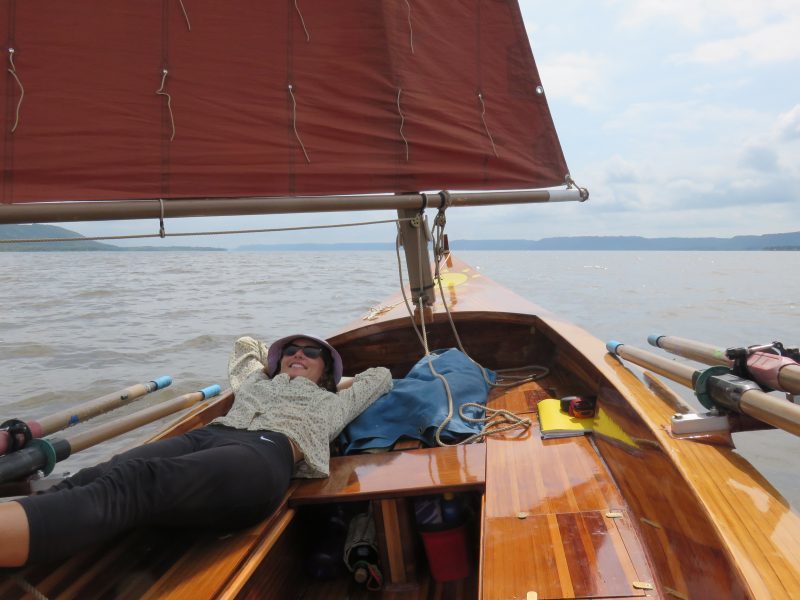 Photographs by Danielle Kreusch and Kyle Hawkins
Photographs by Danielle Kreusch and Kyle HawkinsA smile of running satisfaction came over me on our second go of Lake Pepin, the largest lake on the Mississippi. Our first attempt pitted us a against a strong headwind. We had to give up the fight, retreat, and wait to try again. Our patience was rewarded the next day with 30 miles of easy sailing.
We raised the sail even though the breeze was quite light. My chafed beginner’s arms and hands appreciated the break as we drifted leisurely down the river and the current moved us more than the wind. Nine miles downriver from the launch, Kyle spotted a break in the trees with patch of flat sand. We set up camp and enjoyed a glass of red wine by the campfire. We were both unaccustomed to rowing, and our muscles ached as we lay down in the tent. Sleep came quickly.
We covered about 8 to 10 miles a day for the first few days, and as we became comfortable rowing long hours we averaged 17 miles a day. The St. Croix River meanders 150 miles between Wisconsin and Minnesota and brought us through a few towns—Osceola, Stillwater, Hudson— but we had 10 days’ worth of food and water aboard so we rowed on by, preferring the quiet of the river valley, where we were surrounded by towering cliffs and dense forest.
As we were closing in on Prescott, Wisconsin, and the end of the St. Croix, we were rowing into the evening against 15 knots of wind and being chased by a thunderstorm. Kyle and I pulled hard on the oars as we went under first the highway bridge, then the railroad bridge, at the mouth of the St. Croix, marking the start of our journey on the Mississippi River. The deep blue water below us became murky until it faded into an opaque brown.
Quickly pulling up on Prescott Island, we found that we were sinking into deep muck surrounded by poison ivy. It would be getting dark soon, and with the thunderstorm approaching, we did our best to secure SØLVI on the muddy shoreline and set up camp while avoiding the poison ivy.
After we broke camp the following morning, I took my place at the oars and Kyle pushed us from the black mucky shoreline. I carefully guided us around the fallen trees and pointed the bow into the south wind. We rowed together for a few minutes before we could see our first lock and dam. Kyle stowed his oars while hailing the lockmaster over the VHF radio. At the same moment, a large towboat was working downriver which forced us to maneuver quickly to the other side of the channel to get out of the way.
With wind howling, small wavelets splashing, and a fast current, we eagerly waited for the okay to enter the lock. At the sight of the green light and the sound of the horn, Kyle and I rowed cautiously in. Lines were handed down to us, and we relaxed a bit while the lock slowly lowered us down. The large doors creaked open and we rowed past the cement walls and back into the open river. We heard the voice of the lock master come over channel 16, “Row, row, row your boat…,” his raspy voice sang. Laughing, we looked back and waved to the gray-haired man watching us from above.
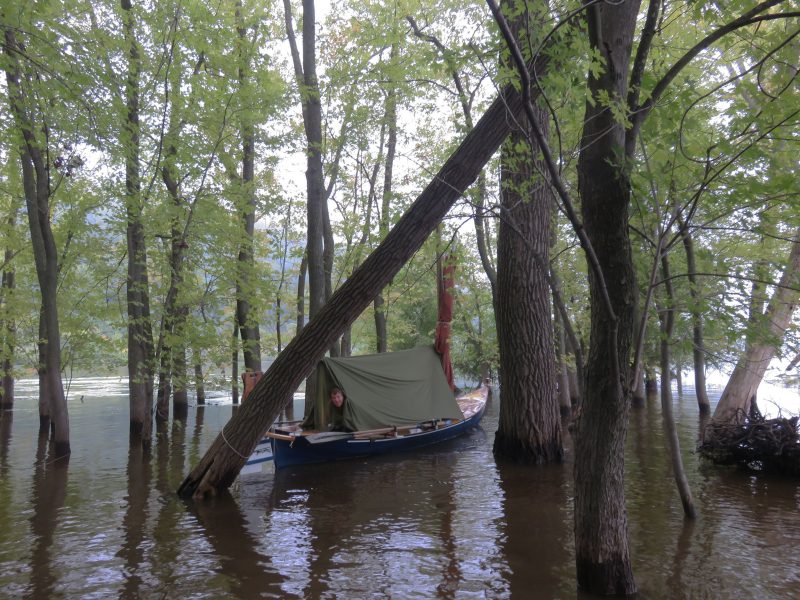
At De Soto, Wisconsin, the flooded Mississippi River had us taking refuge under our boom tent. We waded through a nearby drainage tunnel that took us under a railroad to a lively pub where we enjoyed our first cold brews of the trip.
By the end of our third week, Kyle and I were covering 20 to 30 miles a day. On good days more than half of those miles were under sail, but when there was either too little wind or wind in the wrong direction we spent our days rowing.
We left camp and rowed into the chilled, fog-covered river, crossing the Wisconsin/Illinois border as the sun was rising and. As we made a turn out of a small side channel the wind howled, and instantly we felt the oars get heavy. We worked against a 15-knot headwind, staying close to the shore to avoid its full strength.
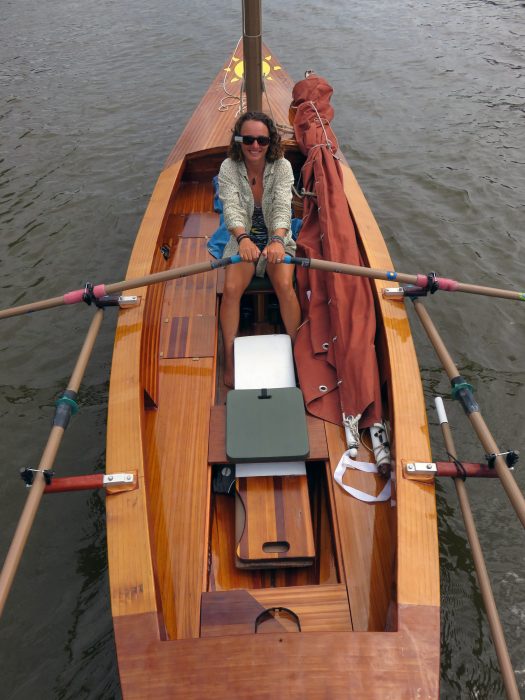
Two weeks into the journey and SØLVI was still so shiny! My faithful bicycle mirror, clipped to my sunglasses, guided the way. We kept our life jackets at our feet, ready to grab, for the entire trip.
Two hours later, we were 10 miles downriver, still tugging hard on the oars. Kyle checked the chart, and noted a series of sloughs that ran parallel with the main channel. At our first opportunity we veered left into a narrow slough. This provided a welcome reprieve and we meandered through a slender waterway covered with a canopy of trees. Unfortunately, none of the sloughs lasted long, and each time we poked our bow out into the main river, the wind pushed relentlessly against us.
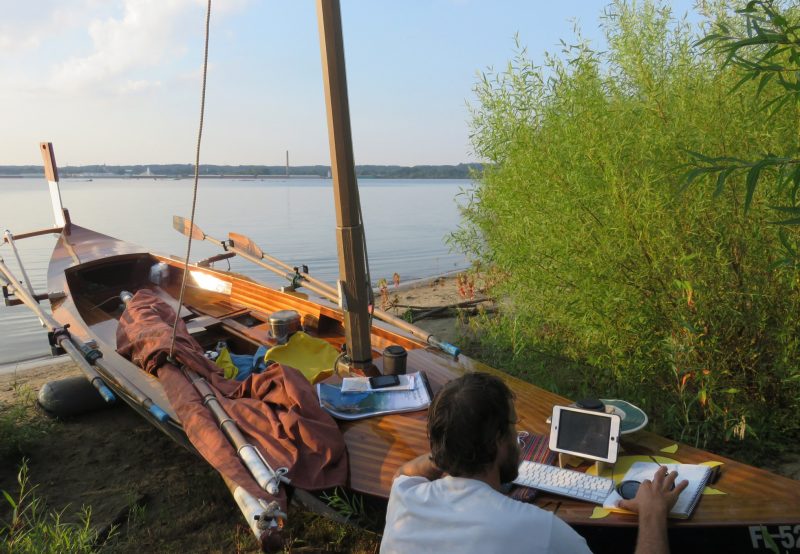
Camped on an island across from Fort Madison, Iowa, we found a cellular hotspot that gave us internet access in a beautiful setting. Kyle checked the weather and responded to some emails while I set up camp and prepared for dinner.
While Kyle was busy making lunch, I continued to row us downriver. If I set my oars down for a split second, the wind would push us back upriver. We were exhausted and fed up with the fight against a wind gusting to 20 knots when Kyle spotted a large tree slowly drifting downriver, quickly rowed over to it, and looped our painter around the mostly submerged trunk. Giggling at our strange tow, I stowed my oars as the log pulled us down river at a fairly consistent 2 knots, not quite as fast as the 3 knots we had been making rowing into the headwind, but a great relief that gave our arms a rest and lifted our spirits.
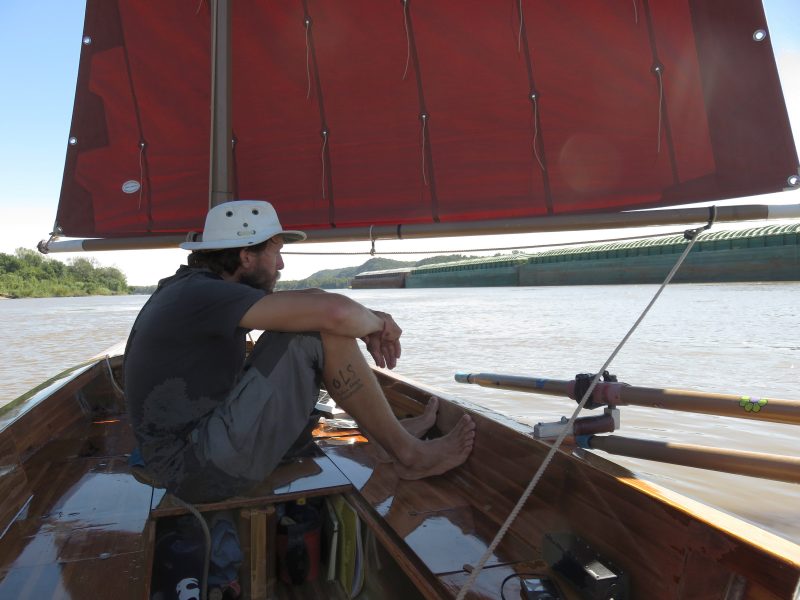
The constant commercial traffic of the Mississippi kept us on our toes. Here, near Memphis, southbound barges slid by at 7 knots, nearly silent until the three-engine tow came along side us, black smoke lingering behind it.
Our confidence and strength grew as we voyaged down the Mississippi. We became comfortable making 30 miles a day, and mud and mosquitoes became our new normal. The river grew too, as we cleared the last lock and dam near St. Louis and entered the lower Mississippi. Many of the towboats there pushed rafts of over 40 barges, more than three times the size of the rafts we’d become accustomed to.
Kyle and I found a pleasing rhythm in our days; the river and its shoreline became our home, the people along the way became our community, and sailing, rowing, and caring for SØLVI was our job. Each night we’d haul SØLVI ashore on a sandbar, quickly turn it into a temporary home by stringing up clotheslines to air clothes and sleeping bags, laying out a kitchen around a campfire, and setting up our tent. Each morning, as we pushed SØLVI off the beach, we’d look back at the footprints we’d left behind, knowing those would be gone with the next rain or rise of the river.
After a long muggy day of rowing 33 miles near the Kentucky/Tennessee border, we landed on one of the many massive sandbars that the line the lower Mississippi River. We pulled SØLVI up on inflatable rollers, and hauled her a good safe distance from the water. Kyle drove a stake to secure SØLVI for the night and we each went our own direction in our wordless routine. I grabbed the tent, sleeping pads, and bag; Kyle headed for the driftwood on the far end of the sandbar island. The sun descended over the riverbank, and the sky glowed orange, yellow, and pink. I grabbed the ground tarp, gave it a couple shakes, and let it flutter to the area of sand that would be our home for the evening. Spreading the ground cloth, tent, and fly was like making the bed at home.
When fish leaped from the orange-tinted river I would stop to watch their rings of ripples drift downstream and then realize I was standing stock still as if time had stopped. In spite of my halting progress, within 30 minutes the empty sandbar was transformed into a temporary home. I placed our books and notebooks in the tent and walked over to the smoking fire pit Kyle had dug into the sand. I plopped down in my folding chair and opened cans and measured rice for a dinner of burritos. Hours slipped by as we enjoyed a warm meal, then glowing embers, and then a clear, starlit sky.
The Lower Mississippi is surrounded by farmland, but it is isolated by levees that create a sense of solitude and independence. Kyle and I were grateful for our little boat for getting us so far.
" Do you feel that?” Kyle’s sleepy voice asked in the predawn morning. Rubbing the sleep from my eyes I sat up, still cocooned in our double sleeping bag. I felt a cool breeze rush across my face through our open tent doors. A northerly wind. I imagined what it would be like to have a full day of running downwind. Kyle and I packed up camp, made breakfast, and prepared SØLVI for the day; we both moved a bit quicker than usual, eager to take advantage of the favorable wind.
An hour later, I was in my rowing seat as Kyle pushed us off the sandbar. I untied the tiller as Kyle heaved on the main halyard releasing our tanbark sail from where it had been resting during the last windless week. Now the wind was blowing at a consistent 8 knots from directly astern and we were on a stretch of river between Missouri and Kentucky that was fairly straight, with only small and subtle bends. A luscious green shoreline surrounded us on both sides and as I watched the trees go by the sound of water rushing under SØLVI’s hull filled my ears as we cruised down the middle of the empty river.
Kyle lay on his back playing his harmonica, improvising gentle tunes for a quiet morning. With each gust SØLVI surged forward. As the sun made its way across the blue sky, the wind picked up and we put in a reef. We passed under a bridge where a man in a lift was working—he stopped what he was doing to wave and watch as we sailed by below him. By 4:00 p.m. we had covered over 30 miles under sail and were ready to camp. We dropped the sail and rowed to the left bank where there was a break in the trees and a small sandy beach.
A few days after reaching Tennessee, we rowed around the south-pointing tip of Mud Island, a nearly 3-mile-long peninsula really, into the small inlet between Memphis, Tennessee, and the river. Having no idea where to stop or put the boat, we headed for a small cluster of masts a half mile to the north. A small sign indicated we had arrived at the Memphis Yacht Club. We secured the boat at the fuel dock, grabbed our water jugs and a few dollars for ice, and went to inquire about a place to stay for the night.
The woman working at the yacht club stared at us and our boat quizzically for a moment before showing us the hose and ice chest. When we asked if we could spend the night in a slip, her surprised response was, “Can you sleep on that thing?” After I explained that our boom tent and sleeping boards converted the boat into a compact and cozy liveaboard, she gave us the okay. We rowed SØLVI into an oversized slip and arranged docklines.
A few minutes later, a man who was staying on a massive yacht a few slips down came and introduced himself as Captain Mark. He had lively blue eyes, a friendly smile, and a very firm handshake. He asked about our boat and our journey. After a few good laughs (and after making sure we had indeed come all the way from Wisconsin), he volunteered to drive us to the store to resupply our groceries. At other towns we had walked as many as 4 miles to get to a grocery store, so we gladly accepted his offer.
After shopping, we put several full bags in the back of Captain Mark’s truck, grateful we wouldn’t have to carry the load in my backpack. Later that afternoon we walked into Memphis, the first big city we had visited since leaving Wisconsin 1,200 miles upstream. I caught myself gaping at all the cars, people, noises, construction, and tall buildings. Even the smell of the soap on my hands after using a public restroom was overwhelming.
Kyle and I kept wandering and ended our evening at a small cafe on Beale Street listening to the blues harmonica. It was dark by the time we retreated to the boom tent covering SØLVI.
Two days south of Memphis, a blustery southern wind had kicked up. Rowing into it was so exhausting that we decided to sail, tacking back and forth across the river. While tedious, it provided a reprieve from the slow grind of rowing into the strong headwind. Fall was approaching and the number of towboats making their way upriver for the autumn harvest increased, adding other obstacles. When a tow was coming our way we dropped the sail and rowed out of the channel. Even with the frequent interruptions to sailing, we passed the morning maneuvering downriver rather effectively.
The sun was sitting just above us as a tow was making its way upriver, so we hugged the inside channel markers, thinking we could safely continue sailing just on the edge of the deep water. The towboat made a change of course that we hadn’t anticipated, so to stay clear we moved just outside the channel. SØLVI came to a sudden stop to an excruciating sound of wood splitting and water rushing into the boat. I shouted at Kyle, “Water’s coming through the daggerboard trunk!”
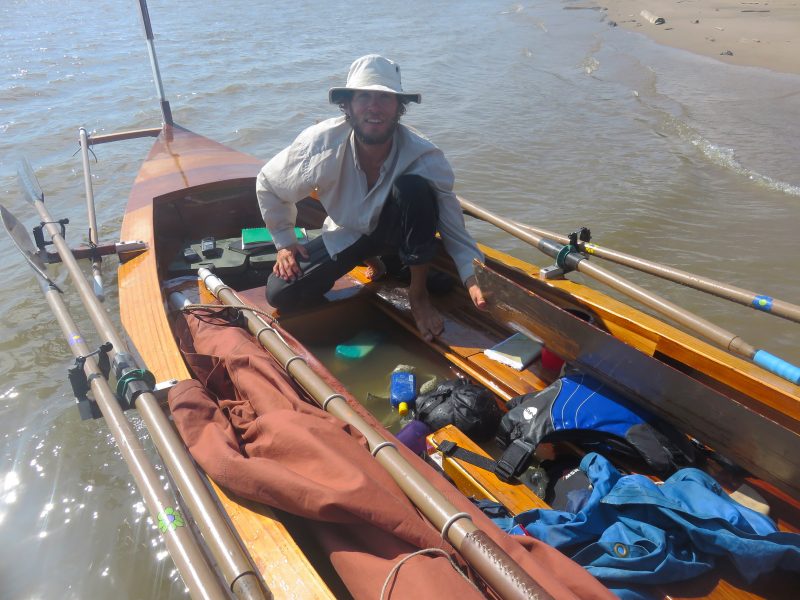
Thirty miles South of Memphis, we hit a submerged wing dam and Kyle was soon surrounded by all our floating belongings. Despite my constant bailing I was unable to get the water below this level. Fortunately everything within the lockers stayed nice and dry.
We had struck a wing dam, one of hundreds along the Lower Mississippi River. They are rows of piled rocks sticking out from shore to hold the river in its course and keep silt from accumulating in the channel. During low water the wing dams are exposed, but at normal river levels they may be hidden just below the surface of the muddy water.
The current, running only about 2 knots, was a powerful force pushing against SØLVI. We dropped the sail and struggled to pull the daggerboard free. Kyle hopped out and got SØLVI to heel enough to free the board; I bailed frantically while he got back aboard. Bailing seemed useless as the water didn’t seem to go down, but it never rose above the seats—SØLVI had plenty of built-in buoyancy, enough to keep us afloat. My heart was racing as Kyle rowed us to the nearest sandbar.
We came to a halt and got out to haul SØLVI up onto the bar. We inspected the damage. Kyle grabbed the daggerboard and began to laugh. “I guess I overbuilt this,” he said. “It was supposed to break, not the trunk.” The board was mangled but otherwise intact. We were both laughing as we put our gear on the sandbar.
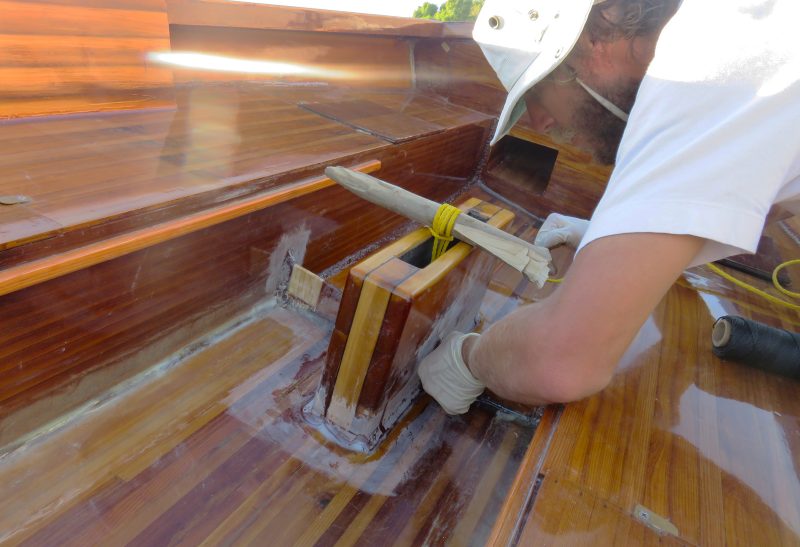
We had enough fiberglass and epoxy in the repair kit to fix the damaged trunk during a forced stay on a Mississippi River sandbar.
Kyle laid out fiberglass, epoxy, fumed silica, gloves, and mixing cups, then with a look of satisfaction said, “We can fix the boat right here.” We made camp, and over the course of three days put SØLVI back in working order. We added piece of cedar driftwood as a support beam with the hopes of preventing the daggerboard trunk from breaking again.
We always carried enough food and water to tide us over in case of emergencies, so we enjoyed the layover. At night, after hours of repairwork, we sipped a bit of red wine and played Frisbee, taking full advantage of being shipwrecked.
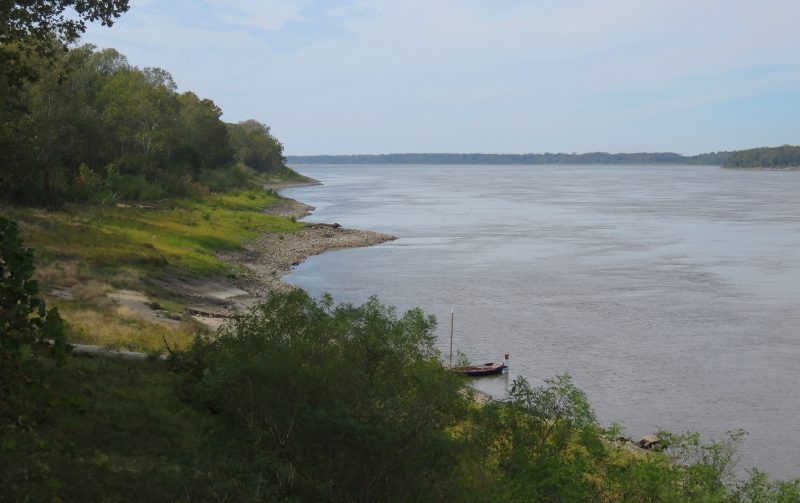
Rowing along one afternoon we heard the soft, kind voice of an older gentleman from the shore: “Do you guys want to come visit?” We spent the afternoon on the deck of his cabin, eating lunch and enjoying the view; one of the many joys the leisurely pace of life on the river encouraged. We camped on the Mississippi side of the river, downstream from Helena, Arkansas.
Our repair held, and we continued downriver and crossed the Arkansas/Louisiana border. Keeping away from the large tows was beginning to wear on us, so to avoid the even heavier ship traffic from Baton Rouge to New Orleans, we decided to take a route less traveled: The Atchafalaya River. This distributary is 137 miles long and would take us to Morgan City, a Mississippi River delta town just 25 miles from the Gulf of Mexico.
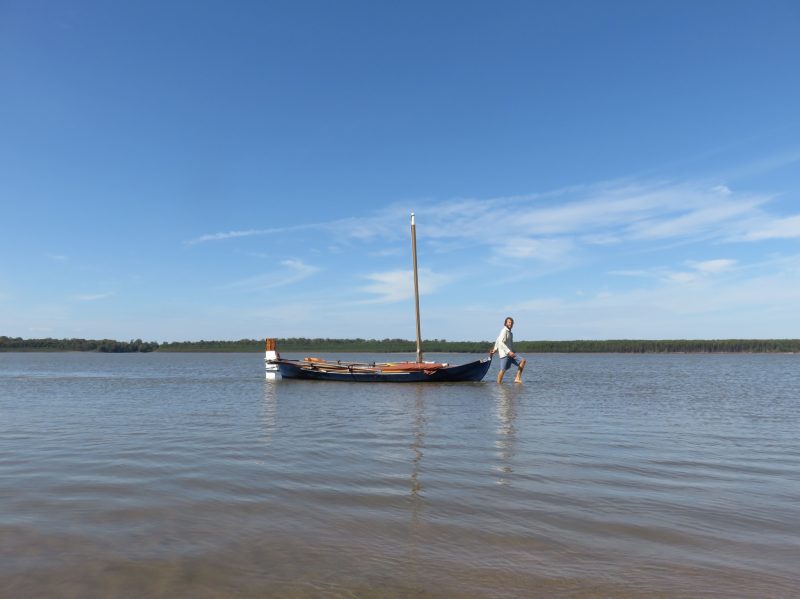
Just south of Vicksburg, Mississippi, we made camp early to celebrate Kyle’s 30th birthday. We stayed the next day to weather some rain and high winds. This was the only time someone asked us to leave a campsite along the river. The island’s caretaker was polite and let us stay until morning, but claimed they had suffered vandalism and theft at the hands of campers.
Eight river miles north of Baton Rouge, we took a right turn off the Mississippi and entered the locks at the Old River Dam. As we were lowered, the old lock creaked and groaned in the early-morning quiet. The lock gates opened to the largest wetland in the United States. Muddy shores were covered in green marsh and cypress trees; alligators basked in the sun. With the wind behind us we set sail and maneuvered down the middle of the river, and didn’t see a single boat the entire day.
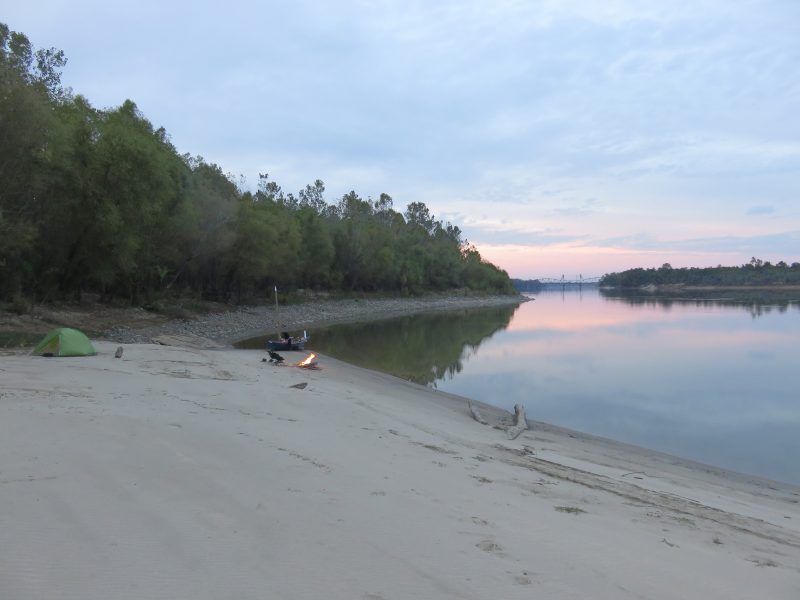
The Atchafalaya river was a great treat after the heavy commercial traffic on the big Mississippi. Camping could be a challenge because of the often endless mud banks, but this spot was nearly perfect.
The wind followed us and as the sun settled on west bank, we searched under a pastel-streaked sky for a place to camp. Mud lined the river as far as we could see, so as Kyle rowed us toward shore, I slipped on my rubber boots. I stepped into the deep mud and we maneuvered SØLVI onto a roller, but neither of us wanted to haul our gear across the mud, so we decided to sleep in the boat. We had become quite accustomed to spending nights aboard the boat and slept quite well.
Along the Atchafalaya we saw bobcats, eagles, and more alligators. Except for a few fishing boats, we had the river to ourselves and let SØLVI drift wherever she wanted to during our lunch breaks. We reached Morgan City in mid-November, and surged down the last stretch of the Atchafalaya at a steady 6 knots with a 35-mph wind behind us.
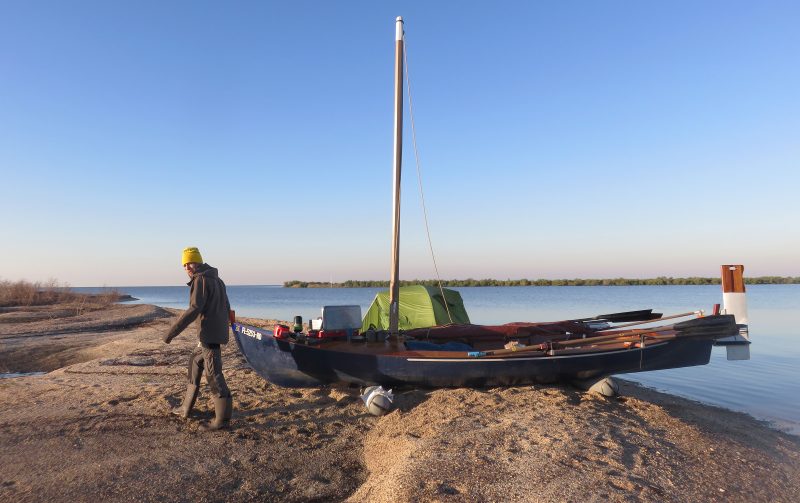
This camp on a crushed-shell beach at the mouth of Oyster Bayou was our last night in protected waters before we ventured out into the Gulf.
We spent the night anchored in a marsh and woke to a still, muggy day. We rowed across a bay surrounded by tall cypress trees, each stroke bringing us closer to the Gulf. The smell of salt was in the air as we turned out of Fourleague Bay into Oyster Bayou and caught our first glimpse of the Gulf of Mexico. The sun was setting over its broad arc, and a pair of dolphins swam alongside SØLVI. Two more burst from the water, airborne. We camped on the edge of Oyster Bayou, and when we crawled into the tent, sleep came fast as the Gulf swell gently broke on the shoreline.
Kyle and I spent the next five days cruising eastward along the open Gulf and hiding behind barrier islands when possible. Our only company was that of dolphins and pelicans. Crossing 6 miles from Isles Dernieres to Timbalier, SØLVI rose on the Gulf swell as we sailed on a beam reach across open water. We made camp on the inside shore of this uninhabited barrier island, then took a walk to the Gulf side. As the sun descended we stood together with our hands clasped, the endless horizon stretched out in front of us.
From Timbailier we made a 16-mile crossing under oars to a sandbar near Port Fourchon, and landed on the beach just as a dark thunder cloud moved in off the Gulf. The next morning Kyle woke me, saying enthusiastically, “Rise and shine! Twenty-one miles of open Gulf today. Let’s go!” It was still dark as we packed up and wolfed down breakfast.
The wind was blowing from the east-northeast as we rowed out into the Gulf; we raised the sail and turned east with the main sheeted in tight. I sat to windward while Kyle pinched into the wind as much as possible to keep our heading. SØLVI pounded into 3′ waves and spray swept over the boat. At midday the wind made a shift to the north and we enjoyed a beam reach, and sailed parallel to the shoreline. Twenty miles later, we were a mile offshore, south of Grand Isle, Louisiana. The wind had all but vanished in the midday heat, so we dropped the sail to let SØLVI drift. Salty, sweaty, and smelly, we plunged into the water and swam around our boat’s scarred blue hull.
We rowed to Grand Isle refreshed. It was the evening of November 25, the setting sun was casting an amber glow on the houses lining the beach. Inside the breakwater, we floated for a few moments and looked out into the Gulf, the sun reflecting on SØLVI’s worn varnish.
After checking in at a marina and converting SØLVI into our tented home, we went searching for some cold drinks and warm food to honor our longest open-water crossing. We opened the iPad for our weather and route research while enjoying some pizza on a patio overlooking the marina. Kyle let out a heavy sigh. The forecast threatened weeks of blustery winds, 8′ to 12’ seas, and severe thunderstorms.
We had hoped to continue island-hopping eastward and eventually make it to my parents’ home in St. Petersburg, Florida, but with large exposed areas between islands, I knew high seas and 35 to 40 knots of wind would even impact the waters behind the barrier islands. Continuing on in SØLVI was neither safe nor feasible.
We retreated to SØLVI where we had a restless night of sleep; the wind picked up and shook the boom tent loudly. The following morning we sipped hot coffee while arranging to ship SØLVI to St. Petersburg. Kyle was scrolling through flight options to get us home while I sat across from him checking the forecast as though it would magically change. We had planned to make it from Wisconsin to Florida under our own power, and I was still determined to do that. “Let’s walk!” I exclaimed.
Kyle was unenthused, but I could tell by his smile that he had another plan. Two days later, SØLVI was on a trailer and on her way. A shiny new tandem bike was delivered to us. SØLVI had done her part, carrying us safely for 2,000 miles, and over the next three weeks DAISY, our tandem bike, carried us the 500 miles to Florida where our family picked us up just in time for Christmas.
While our five-month, 2,500-mile voyage didn’t go exactly as planned, Kyle and I reached Florida together—our bodies, minds, and partnership stronger than we could have ever imagined.![]()
Danielle Kreusch grew up in Salt Lake City, Utah and spent a lot of time hiking and camping in the mountains. After moving to Florida to finish her BA in Psychology and Child Development, Danielle met Kyle Hawkins, who took her sailing on their third date. For the last few years they’ve been living aboard their 35’ Ben Bow cutter and cruise with it whenever possible. This river trip was their first small-boat excursion, and they have both fallen in love with the idea of continuing to travel in small boats like SØLVI.
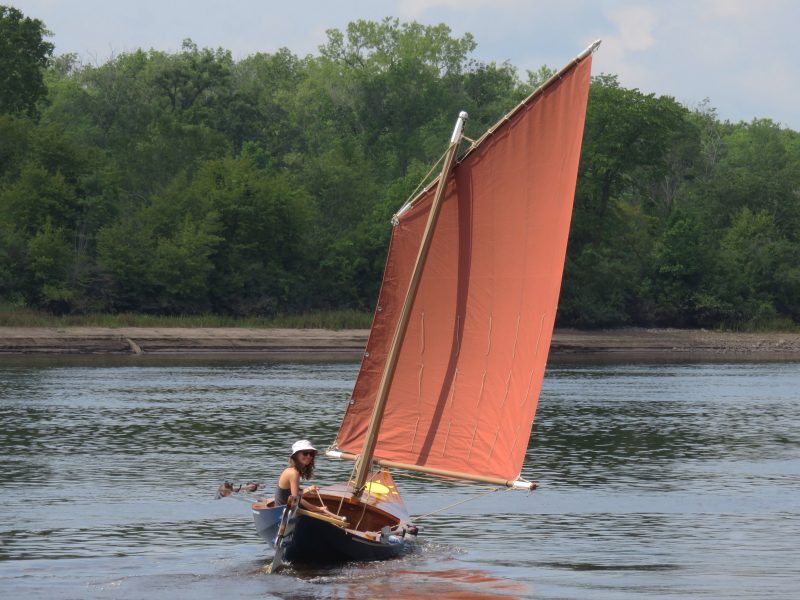
Shortly before embarking on our voyage I took my first solo sail on SØLVI on the upper St. Croix River. This section of the river was Kyle’s boyhood playground.
SØLVI
Bearing a Norwegian name meaning Sun Strength, SØLVI is a faering designed by John Harris of Chesapeake Light Craft. The 19′ 8″ by 4′ 6″ hull was designed for stitch-and-glue plywood, but SØLVI is strip-planked. While strip-planking is most often employed for rounded hulls, SØLVI maintains the chines of the original design. Before fiberglass was applied, Kyle draped blankets on top of the upside-down hull and space heaters beneath it to heat the cedar. The blankets and heater were removed and the fiberglass and epoxy were applied. As the cedar cooled and contracted, the wood’s pores pulled the epoxy in. Deck panels were stripped as flat panels and ‘glassed on both sides before being installed on the boat.
While Harris’s drawings included a pivoting centerboard and rudder blade, SØLVI has a daggerboard to reduce the intrusion into the cockpit. The damage to the trunk that occurred on the Mississippi River was caused by a lateral impact, so a pivoting centerboard may have suffered some damage as well, though the larger area of a longer trunk’s connection to the hull might have fared better.
SØLVI’s outriggers are made of solid 1″x1″ aluminum, 8″ long at the forward rowing station and 13″ long at the aft station. They’re equipped with Concept2 oarlocks. The all-carbon oars are also by Concept2 and originally had hatchet blades. Kyle replaced those blades with more traditionally shaped ocean-rowing blades to make them better suited for rough water. Danielle’s oars were shortened by 6″. In retrospect Kyle would have made the blades 1″ narrower to make them easier to pull during long hours of rowing.
If you have an interesting story to tell about your adventures with a small wooden boat, please email us a brief outline and a few photos.
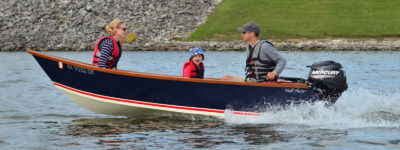
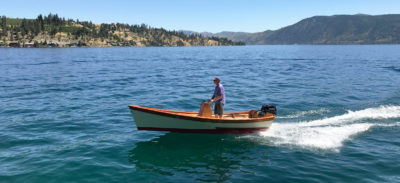
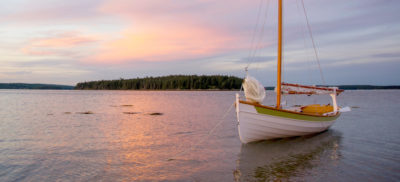
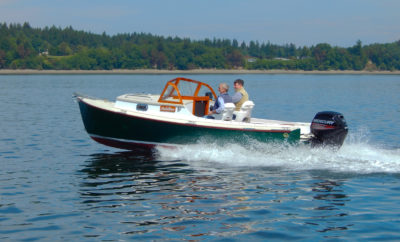
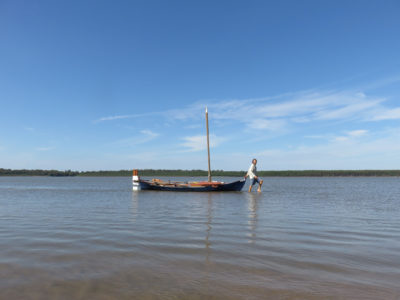
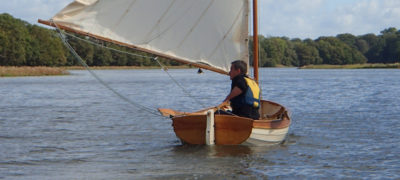
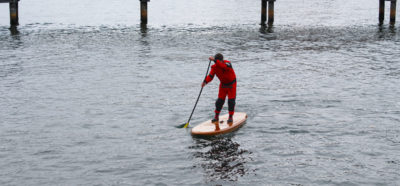
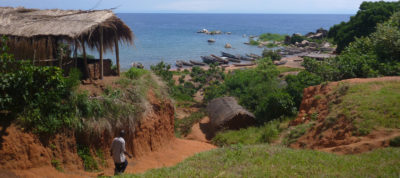
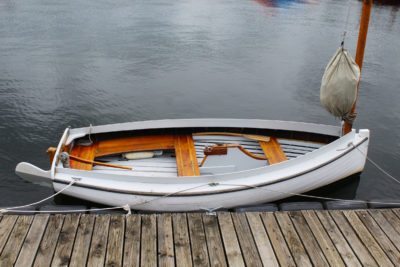
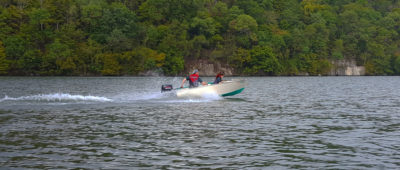
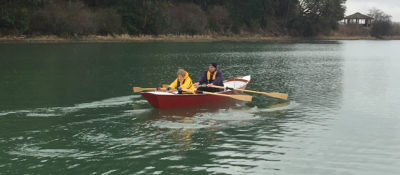
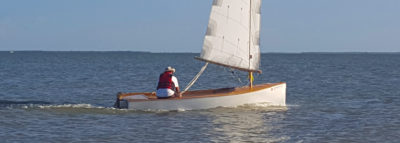
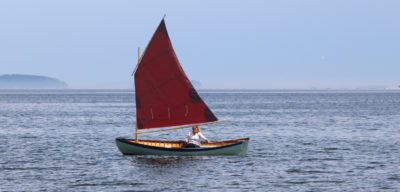
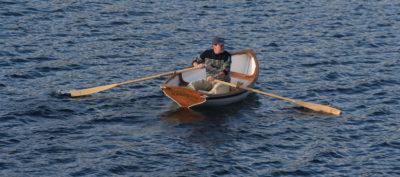
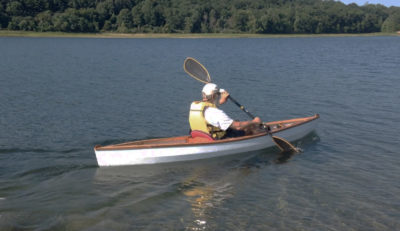
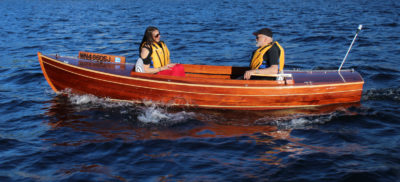
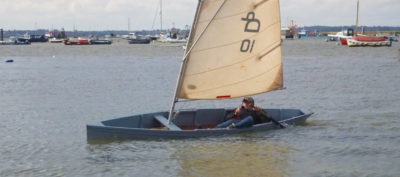
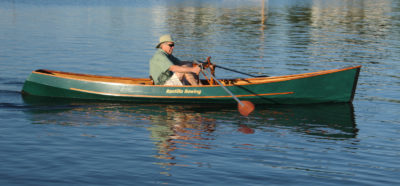
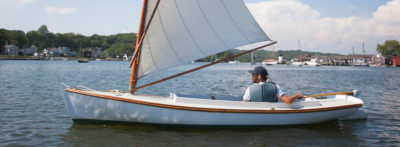
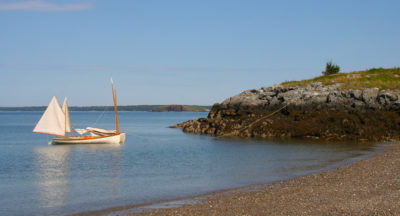

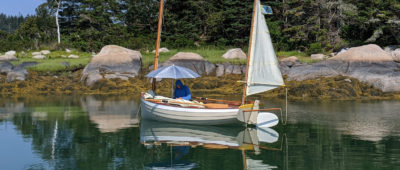
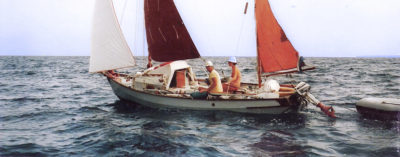
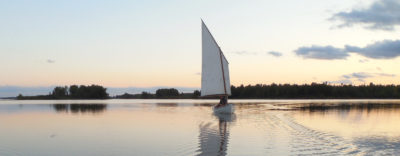
Wonderful adventure and well told. Thanks for sharing.
I grew up on the Upper Mississippi around La Crosse, Wisconsin. The river still has a strong pull for me. Great trip!
This is a great story reminds me of one of my favourite books, The Unlikely Voyage of Jack de Crow, by A. J. Mckinnon. Just goes to show you don’t have to cross oceans in big boats to have fantastic adventures. I’m inspired
Great story, well written. The tandem bike for the last 500 miles was final proof of good seamanship!
What an inspiration. Reading these wonderful stories has inspired me to undertake a decent adventure rowing across the notorious Bass strait between Wilson’s promontory and Tasmania in Australia. I am an old fella now, pretty fit at 76, and will have to behave like the old bull. I notice previous adventurers have gone on a date whereas I will be going on the weather. I have a spare dory, any takers. My nephew seems to think the dory less seaworthy than a kayak. Read “Bad Timing” and make up your own mind. Johnny Gaco
Design of sailing boat developed on the east coast of Scotland, used by Scottish fishermen from the 1850s until well into the 20th century. These boats were mainly used to fish for herring using drift nets, and were known as herring drifters. Varied in design, they can be categorised by their vertical stem and stern, their long straight keel and wide beam.
Thank you so much for this wonderful article. What a great trip you had.
Thank you. Enjoyable and inspiring story. It makes my wonder if there’s a kit or plans for a “fast” row boat and sail that has a cabin for two.
Thoroughly enjoyed accompanying you all on your adventure. Thanks for sharing. I’m aging out of long voyages, but adventures like yours prompt fun day paddles, small boat sails, and have us building a small 12′ row-and-sail lugger for the future. Play safe.
You ruined the entire article with “hotspots and emails.” Seriously?
How does this ruin it? It’s 2023. People have lives to maintain, even if they are away adventuring. ?
An inspiring account written by a thoughtful, gifted writer. Great prose!
If you haven’t already read it, you would enjoy Rinker Buck’s “Life on the Mississippi.” He made much the same voyage on a flatboat (30′ or so), equipped with an outboard, but often relying on the river to carry them along (he usually had a crew of 2 or 3 others with him).
Your experience with the dagger board and the wing dam reminded me why I prefer centerboards, even though I agree they have their drawbacks too. But then I think about any number of small (and occasionally large) boats by Phil Bolger that use lee boards, which are another way to control leeway, and also have their own set of problems. Might have been worth considering. Though you’d have to design your own, their flexibility in installion would make this reasonably doable. Even L. Francis Herreshof used them in his “Meadowlark.”
I enjoyed reading your account. I have some river miles on the St Croix and Mississippi myself. I cruised both in a 13’6″ tiny wooden runabout and camped out on the various islands often though its been 50 years since then. Thank you the trip down memory lane.
Dave